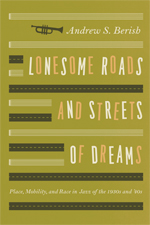
![]()
Andrew Berish
Associate Professor
Humanities and Cultural Studies Department
Email: aberish at usf.edu
Listen to my recent interview with Matt Smith-Lahrman on the New Books in Popular Music Website.
My recent book, Lonesome Roads and Streets of Dreams: Place, Mobility, and Race in Jazz of the 1930s and ’40s (University of Chicago Press, 2012), examines the ways swing-era jazz represented the geographic and demographic transformations of American life during the Great Depression and Second World War. I have also published on jazz guitarist Django Reinhardt (Jazz Perspectives) and his place in jazz history and musical practice. An essay on Duke Ellington in the 1930s will appear in The Cambridge Companion to Duke Ellington, and another essay on Ellington and his relationship to Tin Pan Alley will appear in Duke Ellington and His World (Princeton University Press).
Currently, I am working on a study of Tin Pan Alley song during the Depression and Second World War. Can the sounds of popular song provide scholars with new historical information and perspectives on this era? Previous studies of Tin Pan Alley of this era have focused heavily on the "classic" songs and songwriters of this Golden Age of the American Songbook: George and Ira Gerswhin, Richard Rogers, Cole Porter, Irving Berlin, among many others. I want to substantially expand the number and kinds of songs considered, to embrace traditionally discarded songs such as "sweet" sentimental ballads and "corny" novelty tunes. Looking broadly at the popular song of the era, I believe, allows us to see some new and different patterns in American cultural life, especially ones that trace out tensions in American attitudes toward emotional expression in daily life.
At USF I teach courses on American life of the 1930s and ’40s, jazz and civil rights, the analysis of popular music, and the role of place and mobility in American historical experience.

“Leisure, Love, and Dreams in Depression America: Duke Ellington and Tin Pan Alley Song” in Duke Ellington and His World, ed. John Howland. Princeton: Princeton University Press. Forthcoming 2013.
“Music and the Great Depression,” and “Charlie Barnet,” in The Grove Dictionary of American Music, Second Edition, Charles Garrett, editor-in-chief. Oxford University Press. Forthcoming.
“Duke Ellington in the 1930s,” in the Cambridge Companion to Duke Ellington, ed. Edward Green. Forthcoming. Cambridge University Press.